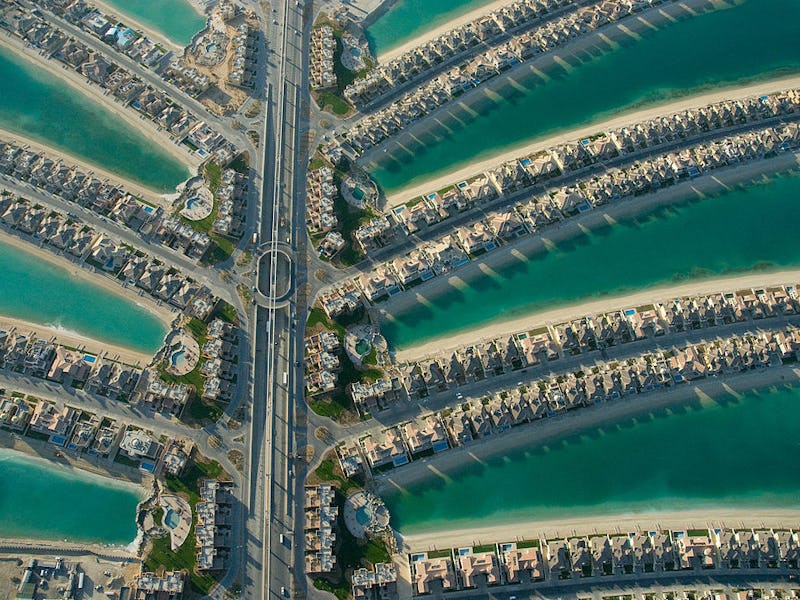Artificial Islands Baffle the United Nations
Shorelines are increasingly impermanent, a fact international law can't get its arms around.

Despite global shorelines that are increasingly threatened by rising seas and storms, coastal development is, ironically, all the rage — just look at Dubai’s massive artificial island, shaped like giant palm trees and a map of the world. It’s a potent signal of wealth and power; after all, island-building is inherently political. That fact seems to have escaped the U.N. when it drafted its United Nations Convention on the Law of the Sea, signed in 1982. Although artificial islands are addressed in the policy, it’s clear the organization didn’t foresee any major diplomatic problems arising from their construction.
In a world that is rapidly changing both physically and politically, that’s going to be a problem, and it’s going to get worse.
Few things cause more international tension than access to coasts, oceans, and their resources, and climate change promises to intensify that conflict. The laws of supply and demand suggest that as coastal real estate dwindles, its value will go up, creating economic and political pressure to not only shore up existing coasts, but create new coastal real estate altogether — this, while coasts and islands elsewhere are disappearing.
Dubai's palm islands collectively add more than 300 miles to Dubai's coastline.
The U.N. policy is essentially this: In your exclusive economic zone that extends up to 200 nautical miles from your coast, feel free to build islands — just don’t put them in the way of ships, and make sure they’re not a safety hazard. If abandoned, clean up the mess. If you have a claim to a continental shelf beyond your exclusive economic zone, that’s cool, go ahead and build islands there, too. On the high seas, anyone can build islands so long as they don’t make too much (whatever that means) of a mess.
The international laws seem to rest on two flawed assumptions: that coastlines are fixed entities, and that artificial islands are apolitical things, unlikely to cause international tension.
The second assumption is easily disproved by current activities in the South China Sea. There, the Chinese government claims the whole thing as territorial water, right up to the coastal zones of neighboring countries, despite the fact that most of the water is much closer to those foreign lands than to mainland China. There are several archipelagos of small islands and reefs in the sea, where countries have asserted their claims by scooping them up and occupying them. China in particular has been on a building spree — shoring up small islands and reefs so that its presence in the area is undeniable.
Fiery Cross Reef in the South China Sea in May 2015, at an early stage of construction.
One of these islands, built on Fiery Cross Reef, was built up in recent years from nearly nothing to 665 acres of manufactured land covered in extensive military and civilian infrastructure, including a two-mile runway, a running track, and basketball courts. China has built up at least five islands since intensive reclamation efforts began in 2014.
Countries with competing claims in the area have responded in kind, building their own islands and settlements and infrastructure. These efforts are extremely modest in comparison to what the Chinese government has been able to accomplish in just a few years.
There’s nothing in the United Nations Convention on the Law of the Sea that seems to anticipate the artificial islands might be built in a show of imperial and military might in contested waters. The only mitigation is that, according to the policy, the construction of artificial islands does not affect a country’s claim to ocean territory, either as an exclusive economic zone or as continental shelf. But that, in an attempt to solve one problem, creates another.
The U.N. convention makes a clear distinction between natural and artificial coastal features, but in reality, these edges are blurred. Just as China’s island building projects will help it assert de facto control over the South China Sea, over time historical amnesia tends to do its thing, and we start to regard artificial structures as part of the natural environment.
When does a reef, built up into an island and colonized not only by humans but flora and fauna, become a natural thing? To answer “never,” as the U.N. appears to, is both impractical and shortsighted. The policy gives status to inhabited islands, but what of inhabited artificial islands? This is unclear, but what is clear is that this is a potential loophole China hopes to exploit.
Shoring up coasts against rising seas is an expensive and shortsighted solution.
Climate change will bring the problem of shifting coastlines into sharp focus. Not only will artificial structures become naturalized over time, natural islands will disappear to the sea. It’s already started happening: One recent study found six small reef islands in the Solomon Islands that are now beneath the waves.
Presumably, if the appearance of artificial islands has no impact on a country’s claim to an area, neither should the disappearance of natural ones. What if an island shored up against the encroaching tide? When does it lose its status as a natural thing and become a human construct?
All coastlines change and evolve over time, due to both human and natural factors. The way humans use the land affects the shore. When artificial islands spring up, nearby natural coastlines change. Storms, which have a more dramatic effect on shorelines, are a natural phenomenon exacerbated by human-caused climate change and sea level rise. Shorelines are dynamic, and teasing apart human and natural impacts is nearly impossible. The U.N.’s approach appears to be to tell nations that they get one shot at defining coastal boundaries — after that, the lines are drawn in the sand. It’s a simple solution, but one that is untenable in an increasingly dynamic human and political world.